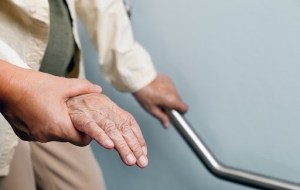Got joint pain? If so, you’re in good company. More than 1 in 5 adults (21.2%) – about 53 million Americans – have some form of arthritis, according to a new report by the Centers for Disease Control.
Marked by chronic joint pain, stiffness and/or swelling, arthritis includes about 100 conditions that affect the joints and surrounding tissues, and it is a leading cause of activity limitations, disability and chronic pain, according to the CDC, which says maintaining a healthy weight and sufficient activity level and avoiding joint injury can help prevent arthritis.

Common Types of Arthritis
By far the most common form of arthritis is osteoarthritis, which causes a break-down in cartilage – or the tissue covering the ends of bones where a joint is formed.
“Osteoarthritis is what most people mean when they talk about arthritis,” says Dr. Seth Korbin, an orthopaedic surgeon and director of joint replacement surgery at Stony Brook Southampton Hospital.
Rheumatoid arthritis (RA) is an autoimmune disease in which the immune system attacks the joints, beginning with the linings. About 0.6% to 1% of the population have RA, according to the American College of Rheumatology.
“It is more common in women, though it can affect men, too,” says Dr. Diane Horowitz, a rheumatologist and director of the Rheumatoid Arthritis Center at Northwell Health and an associate professor of medicine at the Zucker Hofstra Northwell School of Medicine.
Gout is another common form of arthritis that is characterized by sudden, severe pain, swelling and redness in one or more joints, particularly the big toe. Caused by a buildup of uric acid in the blood, gout disproportionately affects men.
Lupus, an autoimmune disorder that is significantly more common in women, and other underlying diseases can cause other forms of arthritis.
Osteoarthritis
Age is the most significant risk factor for osteoarthritis.
“The longer we’re on the planet, the greater the risk of having some amount of osteoarthritis,” says Dr. Korbin. According to the CDC report, about 88% of people with diagnosed arthritis are age 45 or older. “But people in their 30s and 40s can have early-onset osteoarthritis,” he says.
Having a family history of arthritis, being obese or overweight and having certain comorbidities also put people at increased risk for arthritis.
“Other risk factors include injuries, whether from sports or work,” says Dr. Korbin, noting that early-onset osteoarthritis is often related to injuries, and it can occur many years after an injury.
Osteoarthritis is typically diagnosed by X-ray, and its progression varies from person to person. Medications such as nonsteroid anti-inflammatory drugs and acetaminophen as well as hydrocortisone injections can alleviate symptoms, but there are no medications to slow the progression of osteoarthritis.
“Losing weight and treating other medical conditions that contribute to symptoms can be helpful,” says Dr. Korbin. Remaining physically active is also important, but Dr. Korbin suggests substituting high-impact activities such as running with riding a bike or doing an elliptical machine. For people who don’t want to part with running, “running on a treadmill is easier on the joints than running on the road,” he says.

Rheumatoid Arthritis
Rheumatoid arthritis (RA) can be diagnosed in adults as young as around age 20, and it impacts women at a 3:1 ratio to men. Increasing age and family history are also risk factors for RA.
“It varies by person, but RA is usually symmetric, affecting both sides similarly, and it’s characterized by redness, warmth, pain and swelling of the joints,” Dr. Horowitz says. While there may be a specific finding on an arthritis patient’s X-ray that may make doctors suspect RA, blood tests are needed for a diagnosis, says Dr. Korbin.
It’s important for people who suspect they may have RA to seek diagnosis and treatment as soon as possible, because unlike with osteoarthritis, there are medications that can slow the progression of RA and lead to a better prognosis over time, Dr. Horowitz says. Untreated RA could lead to joint damage and decreased function, while increasing the individual’s risk for heart and lung disease.
“If you have a good relationship with a primary care doctor, speak to your doctor about your concerns. Your doctor can evaluate the joints that are bothering you and perhaps do blood work,” Dr. Horowitz says. “If you don’t have a relationship with a primary care doctor, you can start with a rheumatologist.” RA is best treated by rheumatologists, who typically prescribe disease-modifying anti-rheumatic drugs (DMARD), a class of drugs that slow disease progression. “Medication is the backbone of RA therapy,” Dr. Horowitz says.
Lifestyle modifications, including maintaining a healthy weight and exercising, can also help improve or prevent RA, says Dr. Horowitz, who adds that “smoking or exposure to cigarette smoke is the biggest controllable risk factor for RA.”



























